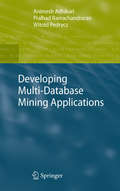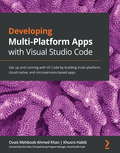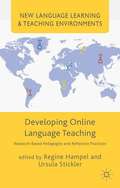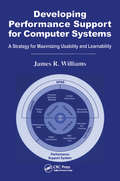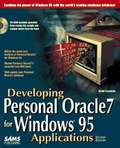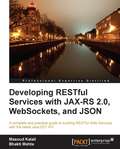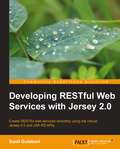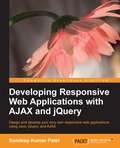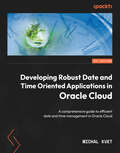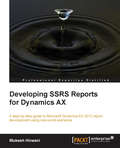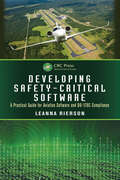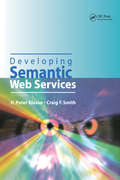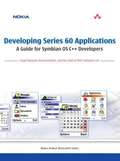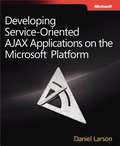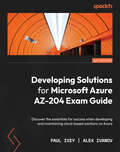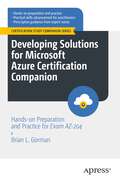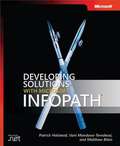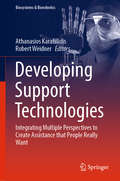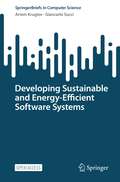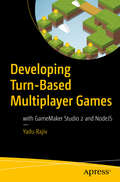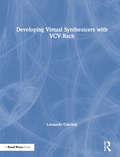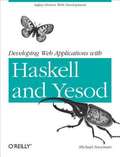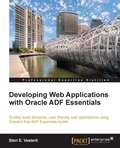- Table View
- List View
Developing Multi-Database Mining Applications
by Witold Pedrycz Pralhad Ramachandrarao Animesh AdhikariMulti-database mining has been recognized recently as an important and strategically essential area of research in data mining. In this book, we discuss various issues regarding the systematic and efficient development of multi-database mining applications. It explains how systematically one could prepare data warehouses at different branches. As appropriate multi-database mining technique is essential to develop better applications. Also, the efficiency of a multi-database mining application could be improved by processing more patterns in the application. A faster algorithm could also play an important role in developing a better application. Thus the efficiency of a multi-database mining application could be enhanced by choosing an appropriate multi-database mining model, an appropriate pattern synthesizing technique, a better pattern representation technique, and an efficient algorithm for solving the problem. This book illustrates each of these issues either in the context of a specific problem, or in general.
Developing Multi-Platform Apps with Visual Studio Code: Get up and running with VS Code by building multi-platform, cloud-native, and microservices-based apps
by Ovais Mehboob Khan Khusro Habib Chris DiasRedefine your software development experience by understanding the extensive features and rich functionalities offered by Visual Studio Code Key Features Leverage the power of the free, cross-platform, and highly customizable code editor to build modern web and cloud applications Edit, debug and deploy on Microsoft Azure with Visual Studio Code Learn how to customize features and install a wide variety of third-party extensions Book Description Microsoft Visual Studio Code is a powerful, lightweight code editor for modern web and cloud development. It is a source code editor that can be used with a variety of programming languages, which works on multiple platforms such as Linux, Windows, and macOS. This book provides extensive coverage of the tools, functionalities, and extensions available within the VS Code environment that will help you build multi-platform apps with ease. You'll start with the installation of VS Code and learn about various tools and features that are essential for development. Progressing through the chapters, you'll explore the user interface while understanding tips and tricks for increasing productivity. Next, you'll delve into VS Code extensions and discover how they can make life easier for developers. Later, the book shows you how to develop a sample application with different programming languages, tools, and runtimes to display how VS code can be used effectively for development, before helping you get to grips with source code version management and deployment on Azure with VS Code. Finally, you'll build on your skills by focusing on remote development with VS Code. By the end of this book, you'll have the knowledge you need to use Visual Studio Code as your primary tool for software development. What you will learn Explore various editing, formatting, and navigational features of VS Code Understand how to add, delete, and configure extensions in VS Code Develop web APIs using Node.js, Java, and Python in VS Code Develop background service in .NET Core and explore Dapr Delve into debugging techniques such as breakpoints, log points, and data inspection Use Git with Azure DevOps to share and synchronize code with VS Code Create custom extensions in VS Code to increase developer productivity Understand the concepts of remote development using VS Code Who this book is for This book is for software developers, web developers and polyglot programmers, who are working with any language or framework such as Python, Java, Node.js, or .NET and are looking to learn how they can create multi-platform, microservices based, cloud-native applications while effectively using Visual Studio Code for editing, debugging, version management and deployment. Basic software development skills are a must to grasp the concepts covered in this book.
Developing Online Language Teaching
by Regine HampelWhen moving towards teaching online, teachers are confronted every day with issues such as online moderation, establishing social presence online, transitioning learners to online environments, giving feedback online. This book supports language teaching professionals and researchers who are keen to engage in online teaching and learning.
Developing Performance Support for Computer Systems: A Strategy for Maximizing Usability and Learnability
by James R. WilliamsDeveloping Performance Support for Computer Systems: A Strategy for Maximizing Usability and Learnability provides detailed planning, design, and development guidance for generating performance support for new or upgraded computer systems. Performance support includes documentation, online help, coaches and wizards, training, and other materials necessary to enable users to perform their jobs more efficiently and effectively.This volume offers a strategy for maximizing ease-of-use and ease-of-learning through an integrated performance support systems approach. The text provides how-to guidance throughout that developers can apply directly to the design of their performance support tools and products. Rather than cover a few specific topic areas, it examines the entire spectrum of performance support. The book explains how to match performance support methods to task requirements, gives an overview of important user characteristics, and provides general guidance for presentation, layout, formatting, media selection, the use of color and icons, and accessibility. Evaluation checklists are included in the appendices and are also available online.Although this book primarily addresses the development of performance support for large software systems, the principles and approaches are valuable for any systems development environment.
Developing Personal Oracle 7 for Windows 95 Applications
by David LockmanHere's a complete guide to developing with oracle 7 under Windows 95.
Developing RESTful Services with JAX-RS 2.0, WebSockets, and JSON
by Masoud Kalali Bhakti MehtaWritten as an easy and practical guide, this book is a crash course on using JAX-RS 2.0, JSON, and WebSockets to develop RESTful services.Getting Started with Developing RESTful Web Services using JAX-RS 2.0, JSON, and WebSockets is a perfect reading source for application developers who are familiar with Java EE and are keen to understand the new HTML5-related functionality introduced in Java EE 7 to improve productivity. To take full advantage of this book, you need to be familiar with Java EE and have some basic understanding of using the GlassFish application server.
Developing RESTful Web Services with Jersey 2.0
by Sunil GulabaniThe book will follow a standard tutorial approach and will teach readers how to use the Jersey API for creating RESTful web services.This book is intended for Java EE developers who are building applications on the REST architecture. This is a quick, hands-on guide for learning JAX-RS 2.0. Developers should have some knowledge about RESTful web services but it's not essential to know JAX-RS 1.0.
Developing Responsive Web Applications with AJAX and jQuery
by Sandeep Kumar PatelThis book is a standard tutorial for web application developers presented in a comprehensive, step-by-step manner to explain the nuances involved. It has an abundance of code and examples supporting explanations of each feature. This book is intended for Java developers wanting to create rich and responsive applications using AJAX. Basic experience of using jQuery is assumed.
Developing Robust Date and Time Oriented Applications in Oracle Cloud: A comprehensive guide to efficient date and time management in Oracle Cloud
by Michal KvetCreate robust temporal solutions in Oracle Cloud and spread the solution worldwide by leveraging its regional properties and time zone synchronizationPurchase of the print or Kindle book includes a free PDF eBookKey FeaturesMigrate existing on-premises applications to the Oracle Cloud environment using data migration techniquesHandle date and time values efficiently using Oracle database's available data types and duration modeling principlesApply temporal database models in real-world systems to ensure robustness, security, and performanceBook DescriptionProper date and time management is critical for the development and reliability of Oracle Databases and cloud environments, which are among the most rapidly expanding technologies today. This knowledge can be applied to cloud technology, on premises, application development, and integration to emphasize regional settings, UTC coordination, or different time zones. This practical book focuses on code snippets and discusses the existing functionalities and limitations, along with covering data migration to the cloud by emphasizing the importance of proper date and time management. This book helps you understand the historical background and evolution of ANSI standards. You'll get to grips with data types, constructor principles, and existing functionalities, and focus on the limitations of regional parameters and time zones, which help in expanding business to other parts of the world. You'll also explore SQL injection threats, temporal database architecture, using Flashback Technology to reconstruct valid database images from the past, time zone management, and UTC synchronization across regions. By the end of this book, you'll be able to create and manage temporal systems, prevent SQL injection attacks, use existing functionalities and define your own robust solutions for date management, and apply time zone and region rules.What you will learnExplore the fundamentals and terms related to Oracle Cloud Infrastructure (OCI) and data migrationFollow core principles and date and time element management supervised by ANSI standardizationDiscover the limitations of existing functionalities and conversion methodsBuild robust and secure temporal solutions that are resistant to SQL injection threatsUnderstand time zone management and regional settings by focusing on regional and national conventions and approachesUse Flashback Technology to create temporal models in terms of historical and current statesWho this book is forThis book is for IT specialists, students, system developers, database administrators, and cloud integrators. With a hands-on approach, this book will help you to gain a comprehensive view of the issue of time processing and enable you to develop complex, robust applications that are usable and portable in any region.
Developing SSRS Reports for Dynamics AX
by Mukesh HirwaniWritten as a step-by-step tutorial, covering all technical aspects of AX 2012 reporting to enable you to quickly learn to and develop reports.This book is ideal for developers and administrators, who deal with Microsoft Dynamics AX 2012 reporting in day-to-day scenarios. No prior exposure to Dynamics AX 2012 reporting is assumed. Readers must know about AX architecture, about the AOT, basic X++ skills, and the basics of SSRS.
Developing Safety-Critical Software: A Practical Guide for Aviation Software and DO-178C Compliance
by Leanna RiersonThe amount of software used in safety-critical systems is increasing at a rapid rate. At the same time, software technology is changing, projects are pressed to develop software faster and more cheaply, and the software is being used in more critical ways. Developing Safety-Critical Software: A Practical Guide for Aviation Software and DO-178C Compliance equips you with the information you need to effectively and efficiently develop safety-critical, life-critical, and mission-critical software for aviation. The principles also apply to software for automotive, medical, nuclear, and other safety-critical domains.An international authority on safety-critical software, the author helped write DO-178C and the U.S. Federal Aviation Administration’s policy and guidance on safety-critical software. In this book, she draws on more than 20 years of experience as a certification authority, an avionics manufacturer, an aircraft integrator, and a software developer to present best practices, real-world examples, and concrete recommendations.The book includes: An overview of how software fits into the systems and safety processes Detailed examination of DO-178C and how to effectively apply the guidance Insight into the DO-178C-related documents on tool qualification (DO-330), model-based development (DO-331), object-oriented technology (DO-332), and formal methods (DO-333) Practical tips for the successful development of safety-critical software and certification Insightful coverage of some of the more challenging topics in safety-critical software development and verification, including real-time operating systems, partitioning, configuration data, software reuse, previously developed software, reverse engineering, and outsourcing and offshoring An invaluable reference for systems and software managers, developers, and quality assurance personnel, this book provides a wealth of information to help you develop, manage, and approve safety-critical software more confidently.
Developing Semantic Web Services
by Craig F. Smith H.Peter AlessoDeveloping Semantic Web Services is well-informed about work on WS [Web Services] and the SemWeb [Semantic Web], and in particular . . . understand[s] OWL-S . . . very well . . .. Also, the book . . . fill[s] a need that, to my knowledge, hasn't been met at all. ---David Martin, editor OWL-S Coalition The inventor of the World Wide Web, Tim Berners-Lee, is also the originator of the next generation Web architecture, the Semantic Web. Currently, his World Wide Web consortium (W3C) team works to develop, extend, and standardize the Web's markup languages and tools. The objective of the Semantic Web Architecture is to provide a knowledge representation of linked data in order to allow machine processing on a global scale. The W3C has developed a new generation of open standard markup languages which are now poised to unleash the power, flexibility, and above all---logic---of the next generation Web, as well as open the door to the next generation of Web Services. There are many ways in which the two areas of Web Services and the Semantic Web could interact to lead to the further development of Semantic Web Services. Berners-Lee has suggested that both of these technologies would benefit from integration that would combine the Semantic Web's meaningful content with Web Services' business logic. Areas such as UDDI and WSDL are ideally suited to be implemented using Semantic Web technology. In addition, SOAP could use RDF payloads, remote RDF query and updates, and interact with Semantic Web business rules engines, thereby laying the foundation for Semantic Web Services. This book presents the complete Language Pyramid of Web markup languages, including Resource Description Framework (RDF), Web Ontology Language (OWL) and OWL-Services (OWL-S) along with examples and software demos. The source code for the Semantic Web Author, an Integrated Development Environment for Semantic Markup Languages is available on CD-ROM with the book.
Developing Series 60 Applications: A Guide for Symbian OS C++ Developers
by Leigh Edwards Richard Barker Staff of EMCC Software Ltd.Sixty example applications, focused entirely on native Symbian OS C++ programming.
Developing Service-Oriented AJAX Applications on the Microsoft® Platform
by Daniel LarsonMake your rich Internet applications easier to write, manage, and update by leveraging ASP.NET AJAX, the Microsoft AJAX Library, and the Windows® mmunication Foundation Web programming model. With extensive code samples and guidance from an AJAX expert, you'll learn to separate the Web services API layer and user interface--a service-oriented approach that allows you to easily add features and integrate components as your application evolves. Discover how to: Employ an architecture pattern that highlights the Web services API Tap the AJAX Library framework, extensions, namespaces, and runtime controls Enable authentication, profiles, and authorization using AJAX application services Apply JavaScript models for object-oriented development and XSLT for client-side rendering Use the AJAX Library event-based programming model and component-based JavaScript architecture Deploy Web services and AJAX controls to Windows SharePoint Services® 3.0 and Microsoft Office SharePoint® Server 2007
Developing Solutions for Microsoft Azure AZ-204 Exam Guide: Discover the essentials for success when developing and maintaining cloud-based solutions on Azure
by Paul Ivey Alex IvanovBuild a thorough understanding of the technology, concepts, and development patterns used in building applications in Azure, through detailed explanations, hands-on exercises, and downloadable code samplesKey FeaturesWritten by two Microsoft technical trainers to help you explore the exam topics in a structured wayUnderstand the “why”, and not just “how” behind design and solution decisionsFollow along examples with downloadable code samples to help cement each topic's learning objectiveBook DescriptionWith the prevalence of cloud technologies and DevOps ways of working, the industry demands developers who can build cloud solutions and monitor them throughout their life cycle. Becoming a Microsoft-certified Azure developer can differentiate developers from the competition, but with such a plethora of information available, it can be difficult to structure learning in an effective way to obtain certification. Through easy-to-understand explanations and exercises, this book will provide a more palatable learning experience than what you may expect from an exam preparation book. You'll start off with a recap of some important cloud concepts, such as IaaS, PaaS, and SaaS. From there, you'll learn about each relevant solution area, with use cases. The chapters also cover different implementation methodologies, both manual and programmatic – ranging from compute resources such as App Service and serverless applications to storage, database, security, monitoring solutions, and connecting to third-party services. By the end of this book, you'll have learned everything you need to pass the AZ-204 certification exam and have a handy, on-the-job reference guide.What you will learnDevelop Azure compute solutionsDiscover tips and tricks from Azure experts for interactive learningUse Cosmos DB storage and blob storage for developing solutionsDevelop secure cloud solutions for AzureUse optimization, monitoring, and troubleshooting for Azure solutionsDevelop Azure solutions connected to third-party servicesWho this book is forThis book is for Azure developers looking to improve their Azure development knowledge to pass the AZ-204 exam. This book assumes at least one year of professional development experience with Azure, with the ability to program in at least one language supported by Azure. Existing Azure CLI and PowerShell skills will also be useful.
Developing Solutions for Microsoft Azure Certification Companion: Hands-on Preparation and Practice for Exam AZ-204 (Certification Study Companion Series)
by Brian L. GormanImprove your odds of passing one of the most highly sought-after exams for developers working with Microsoft’s cloud platform: Exam AZ-204: Developing Solutions for Microsoft Azure. This book guides you through practical examples of each of the technologies covered by the exam while exposing you to the settings and interactions between platform solutions that you will need to be in command of to prepare for the exam and to use on your job in Azure development.Chapters in this book correspond directly to the exam skills outline and are delivered in a “from-the-ground-up” approach, allowing you to build your knowledge as you go. This approach serves to help even novice developers get up to speed quickly, while allowing more experienced developers to find the exact topics and scenarios they need to hone their skill sets as they both prepare for the exam and reference information for real-world solutions.As you work through each chapter, you will get an introduction to the topic of the chapter followed by a comprehensive discovery of the key elements of the Azure service(s) being covered. You’ll be guided through solutions by studying typical, real-world scenarios. Each chapter concludes with review questions to solidify your learning and includes links to the corresponding Microsoft Learn modules that are relevant to the concepts in the chapter and associated with each section of the AZ-204 exam.What You Will LearnKnow the essential platform services of AzureDevelop and deploy secure and robust web solutionsArchitect and create serverless solutionsManage containers in the Azure Containers ecosystemChoose the correct messaging and event-handling tools for your applicationsMaster real-world examples and challenges that help prepare you for the AZ-204 examWho This Book Is ForDevelopers planning to take the AZ-204 exam, and developers who want to learn more about development on the most common Azure platform services
Developing Solutions with Microsoft® InfoPath™
by Patrick Halstead Matthew Blain Vani Mandava-TeradesaiBuild innovative, XML-based solutions faster--with expert guidance from three veterans of the Microsoft InfoPath design team. Discover how to use common InfoPath design patterns to accelerate the development of forms with a dynamic, easy-to-use front end that connects seamlessly with middle-tier services and back-end servers, including databases, Web services, and Microsoft BizTalk® Server. The authors walk you through a range of programming scenarios--explaining the pros and cons of various approaches and sharing their best practices and undocumented tips. You'll also find real-world examples, including a complete, three-tier business solution. Discover how to: Customize and deploy your own InfoPath forms, taking advantage of ready-made sample code Create "smart" InfoPath forms to provide a dynamic experience using conditional visibility, data validation, and autopopulation Design a rich form interface with structured and dynamic sections, multiple views, and calculations Build forms-based workflow processing into InfoPath forms using e-mail, SharePoint® servers, and BizTalk Use the Microsoft .NET common language runtime-based object model to increase development flexibility Receive and submit data for your forms using back-end databases and Web services
Developing Solutions with Microsoft® InfoPath™
by Patrick Halstead Vani MandavaTwo former and one current engineer at the software behemoth describe how to use its software package that serves both as a designer for creating XML forms and as an editor for displaying them to be filled out. Anyone familiar with a word processor should be able to follow the discussion. Annotation ©2006 Book News, Inc., Portland, OR (booknews.com)
Developing Support Technologies: Integrating Multiple Perspectives to Create Assistance that People Really Want (Biosystems & Biorobotics #23)
by Athanasios Karafillidis Robert WeidnerThis book shows the advantages of using different perspectives and scientific backgrounds for developing support technologies that are integrated into daily life. It highlights the interaction between people and technology as a key factor for achieving this integration and discusses relevant methods, concepts, technologies, and applications suitable for interdisciplinary exchange and collaboration. The relationship between humans and technology has become much more inclusive and interdependent. This generates a number of technical, ethical, social, and practical issues. By gathering contributions from scholars from heterogeneous research fields, such as biomechanics, various branches of engineering, the social sciences, information science, psychology, and philosophy, this book is intended to provide answers to the main questions arising when support technologies such as assistance systems, wearable devices, augmented reality, and/or robot-based systems are constructed, implemented, interfaced and/or evaluated across different application contexts.
Developing Sustainable and Energy-Efficient Software Systems (SpringerBriefs in Computer Science)
by Giancarlo Succi Artem KruglovThis open access book provides information how to choose and collect the appropriate metrics for a software project in an organization. There are several kinds of metrics, based on the analysis of source code and developed for different programming paradigms such as structured programming and object-oriented programming (OOP). This way, the book follows three main objectives: (i) to identify existing and easily-collectible measures, if possible in the early phases of software development, for predicting and modeling both the traditional attributes of software systems and attributes specifically related to their efficient use of resources, and to create new metrics for such purposes; (ii) to describe ways to collect these measures during the entire lifecycle of a system, using minimally-invasive monitoring of design-time processes, and consolidate them into conceptual frameworks able to support model building by using a variety of approaches, including statistics, data mining and computational intelligence; and (iii) to present models and tools to support design time evolution of systems based on design-time measures and to empirically validate them. The book provides researchers and advanced professionals with methods for understanding the full implications of alternative choices and their relative attractiveness in terms of enhancing system resilience. It also explores the simultaneous use of multiple models that reflect different system interpretations or stakeholder perspectives.
Developing Turn-Based Multiplayer Games: with GameMaker Studio 2 and NodeJS
by Yadu RajivCreate your first turn-based multiplayer game using GameMaker Studio 2’s built-in networking functions as well as using a simple NodeJS server. This book introduces you to the complexities of network programming and communication, where the focus will be on building the game from the ground up. You will start with a brief introduction to GameMaker Studio 2 and GML coding before diving into the essential principles of game design. Following this, you will go through an introductory section on NodeJS where you will learn how to create a server and send and receive data from it as well as integrating it with GameMaker Studio. You will then apply multiplayer gaming logic to your server and unlock multiplayer game features such as locating a player, syncing their data, and recording their session. What You Will LearnDiscover the architecture of GameMaker Studio 2 Add new features to your game with NodeJS modulesIntegrate GameMaker Studio 2 with NodeJS Master GameMaker Studio 2's built-in networking functionsWho This Book Is ForGameMaker Studio users who want to understand how the networking components of GMS 2 work. Basic JavaScript knowledge is required.
Developing Virtual Synthesizers with VCV Rack
by Leonardo GabrielliDeveloping Virtual Synthesizers with VCV Rack takes the reader step by step through the process of developing synthesizer modules, beginning with the elementary and leading up to more engaging examples. Using the intuitive VCV Rack and its open-source C++ API, this book will guide even the most inexperienced reader to master efficient DSP coding to create oscillators, filters, and complex modules.Examining practical topics related to releasing plugins and managing complex graphical user interaction, with an intuitive study of signal processing theory specifically tailored for sound synthesis and virtual analog, this book covers everything from theory to practice. With exercises and example patches in each chapter, the reader will build a library of synthesizer modules that they can modify and expand.Supplemented by a companion website, this book is recommended reading for undergraduate and postgraduate students of audio engineering, music technology, computer science, electronics, and related courses; audio coding and do-it-yourself enthusiasts; and professionals looking for a quick guide to VCV Rack. VCV Rack is a free and open-source software available online.
Developing Web Applications with Haskell and Yesod
by Michael SnoymanThis fast-moving guide introduces web application development with Haskell and Yesod, a potent language/framework combination that supports high-performing applications that are modular, type-safe, and concise. You'll work with several samples to explore the way Yesod handles widgets, forms, persistence, and RESTful content. You also get an introduction to various Haskell tools to supplement your basic knowledge of the language. By the time you finish this book, you'll create a production-quality web application with Yesod's ready-to-use scaffolding. You'll also examine several real-world examples, including a blog, a wiki, a JSON web service, and a Sphinx search server. Build a simple application to learn Yesod's foundation datatype and Web Application Interface (WAI) Use Shakespearean template languages for HTML, CSS, and Javascript output Produce cleaner, more modular code by learning how Yesod monads interact Implement the yesod-form declarative API to build forms on top of widgets Learn how Yesod and Haskell store session data and handle persistence Use techniques to serve an HTML page and a machine-friendly JSON page from the same URL Create reusable components for several applications with Yesod subsites
Developing Web Applications with Oracle ADF Essentials
by Sten E. VesterliDeveloping Web Applications with Oracle ADF Essentials covers the basics of Oracle ADF and then works through more complex topics such as debugging and logging features and JAAS Security in JDeveloper as the reader gains more skills. This book will follow a tutorial approach, using a practical example, with the content and tasks getting harder throughout."Developing Web Applications with Oracle ADF Essentials" is for you if you want to build modern, user-friendly web applications for all kinds of data gathering, analysis, and presentations. You do not need to know any advanced HTML or JavaScript programming. Business logic can be implemented by adding Java code at well-defined hook points, so you do not need do know advanced object-oriented programming--regular Java programming skills are enough.
Developing Web Apps with Haskell and Yesod: Safety-Driven Web Development
by Michael SnoymanThis fast-moving guide introduces web application development with Haskell and Yesod, a potent language/framework combination that supports high-performing applications that are modular, type-safe, and concise. Fully updated for Yesod 1.4, this second edition shows you how Yesod handles widgets, forms, persistence, and RESTful content. Author Michael Snoyman also introduces various Haskell tools to supplement your basic knowledge of the language.By the time you finish this book, you’ll create a production-quality web application with Yesod’s ready-to-use scaffolding. You’ll also examine several real-world examples, including a blog, a wiki, a JSON web service, and a Sphinx search server.Build a simple application to learn Yesod’s foundation datatype and Web Application Interface (WAI)Output HTML, CSS, and Javascript with Shakespearean template languagesGet an indepth look at Yesod’s core monads for producing cleaner, more modular codeProbe Yesod’s internal workings: learn the request handling process for a typical applicationBuild forms on top of widgets by implementing the yesod-form declarative APILearn how Yesod and Haskell handle persistence and session dataServe an HTML page and a machine-friendly JSON page from the same URL
